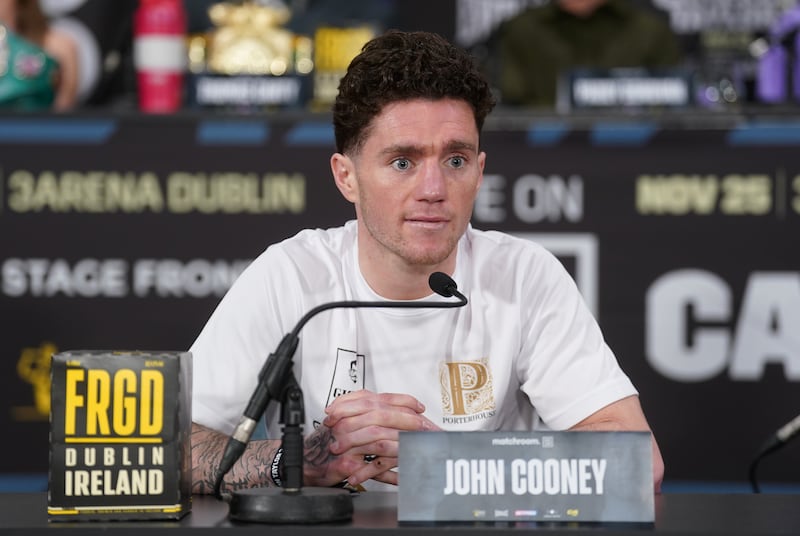The sobering history of boxing has forever been blood and glory. It sits among the risk sports for longer than any other.
Some people choose ripping along country roads at Portstewart, Coleraine and Portrush on Honda Fireblades in the Northwest 200.
Others sit in Nepal or Tibet base camps and see a different kind of majesty in conquering the mountain. But with Everest, motorcycle racing and professional boxing, the sports will always take a few each year.
Last Saturday, 28-year-old super-featherweight boxer John Cooney died after his defeat by Welshman Nathan Howells in Belfast the previous weekend. The Galway boxer suffered an intracranial haemorrhage after the bout was stopped in the ninth round.
Just more than a year ago we watched Cooney win the Celtic title with a first-round win over Liam Gaynor. It was an appropriate stage for such a talent, a sold-out 3Arena in Dublin on the undercard of Katie Taylor’s world title win over Chantelle Cameron.
Cooney’s triumph in Dublin makes this week’s tragedy more poignant. That night he went into the ring with the same confident mindset that Joey Dunlop had when he threw his leg over his machine in Estonia in 2000, or Ireland’s John Delaney when he started off on his journey up Everest in 2011.
What bound them together at the end of their lives was spirit, ambition and a fearless sensibility. But most of all they had bulletproof self-belief. They didn’t just like their chosen sport. It wasn’t a pastime or hobby. They didn’t do it for health reasons, to stay trim or find a social circle.
They didn’t play racing or mountaineering or boxing. You can’t play those sports. They participated because it was part of them.
As always when catastrophe unexpectedly strikes, people clamour for change, look to see if anything can be done so that it will not happen again. Over the years, boxing has done that. Doctors closely monitor the fighters, oxygen is at hand and there is an ambulance on site.
Still, while estimates vary, as many as 500 boxers have died since the sport was formalised with rules by the Marquess of Queensberry in 1884.
In 2018 a book called Dog Rounds – Death and Life in the Boxing Ring was published. Its author Elliot Worsell sought out and interviewed boxers who had killed their opposite number.
One was Barry McGuigan, whose 1982 fight with African opponent Young Ali resulted in the Nigerian being knocked out in the sixth round. Ali fell into a six-month coma before he died of his injuries.
“I hit him right on the nose, his eyes just rolled back. It was a haunting moment. I knew he wasn’t going to get up from that,” said McGuigan.
In 2020 the former world champion appeared in The Mail Online, again talking about the catastrophic incident in London.
“After that I didn’t know if I wanted to box or not. If I can do this sort of damage to someone ... it happens, but it’s such a tragedy and it’s the one thing we as boxing fans don’t want to ever happen again. But it happened before, and it will happen again.”

There was no requirement for McGuigan to be prescient in knowing his tragic night would be repeated somewhere. His continued anguish also spoke to the pebble in the pond and the ripple effect. The team around the boxer, the opponent who caused the injuries and most of all the heartbroken family, whose lives changed forever.
Taking grains of solace, Cooney’s family in a statement spoke of a son, a brother and a fiancee, “who lived and died chasing his dream”. It seemed like cold comfort.
But through their immeasurable grief it also seemed that doing something in death that he loved was a fragment of consolation – perhaps the only one – and an acceptance of his choice.
Some years ago, a motorbike racer described to me what it was like to hit 200mph down a country road. “Green blur, grey blur, red flash. Hedge, drystone wall, post box.” An indescribable cinematic reel of danger.
Like those bikes perilously traversing the northern coast of this island or summiting K2, boxing has the same intrinsic appeal and involves an absence of fear in those who take part.
McGuigan, although he wrestled with his conscience about continuing to box, went on to take the WBA world featherweight title from Eusébio Pedroza three years later at Loftus Road.
In Dog Rounds, Worsell questioned his place in the sport and as a boxing fan asked if he was somehow complicit in the deaths.
[ ‘A lovely sweet kid’: tributes paid to John Cooney after Irish boxer’s deathOpens in new window ]
In a short but all encapsulating synopsis of the book published on Goodreads, the tragedies were described as a trigger for a slew of emotions and consequences.
“Worsell reveals the extent of the devastation left behind,” it said. “In doing so he uncovers an incredible story of guilt, forgiveness, obsession, and violence. What results is a powerful look at the past, present, and future of one of the world’s most dangerous sports.”
Today, those close to Cooney may mournfully recognise some of those things. But their grief won’t change boxing. It will remain dangerous.
Nobody plays the blame game in such calamitous occasions. If they do, then as Cooney is buried in Rahoon cemetery, no less than McGuigan or Howells, in our celebration of boxing we are all in some way complicit.
















